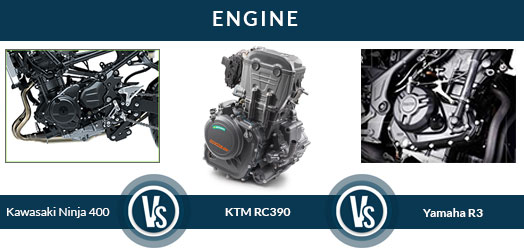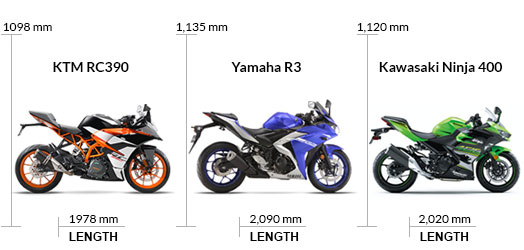All New Kawasaki Ninja 400 Vs KTM RC 390 Vs Yamaha R3
The Indian emergence of Kawasaki Ninja 400 has put a new rival in front of segment leader the KTM RC390 and going to re-launch soon, the Yamaha R3. It will be really interesting to see the commotion in the segment with the introduction of this newcomer. Check out the specs comparison to find out who will be the king of these entry-level supersport motorcycles.
Comparison of Kawasaki Ninja 400 VS KTM RC 390 VS Yamaha R3
Engine:
The Kawasaki Ninja comes laden with an all-new 399cc, parallel-twin, liquid-cooled powertrain that develops 45.6PS of power and delivers 38Nm at 8,000rpm. While, the KTM 390 that is a potent rival for the Ninja 400, is powered by a 375cc single-cylinder liquid-cooled engine. The engine is rated to churn out the maximum power of 43.5PS and the peak torque of 36Nm at 7000rpm. Last but not the least, the Yamaha R3 gets the propelling power from a 321cc, parallel-twin, liquid-cooled engine. The generated power and torque figures from the mill are 42PS and 29.6Nm at 9000rpm. Though, the ongoing R3 model is compliant with the current BS-IV emission norms. The power transmission duty on all the three models is taken care by the common 6-speed gearbox. Comparing all models engine specs reveal the newly launched Kawasaki Ninja 400 knock out the other two by its superior power and torque figures.
Features:
In order to pose a fare competition against the rivals, the Green giant featured Ninja 400 with an array of upmarket updates. It comes equipped with dual LED headlamp setup that is sourced from the Ninja H2, whereas the rear tail lights is also an LED unit that draws inspiration from the Ninja ZX-10R. The instrument console is borrowed from the Kawasaki Ninja 650. Furthermore, the inclusion of an assist and slipper clutch supports seamless transmission.
The KTM RC 390 has also been updated for the model year 2017, received a few new features. It now comes equipped with the slipper clutch assembly as a standard fitment. For which you have to pay an extra amount of Rs 9000 in the older model. Among the gizmos, the 2017 KTM RC390 include ride-by-wire technology and an ECVAP (Evaporative Emission Control System). The other details cues like LCD display in the instrument console, LED headlight and tail lamp units are carried forward as it is from the predecessor model. However, the revived model now gets AHO feature in the same old LED headlamp setup.
Going against these two in terms of features the Yamaha R3 can be considered an outdated model as it did not receive any upgrade over the years. It lacks in important equipment which is standard in other two models such as the slipper clutch and ride-by-wire. Also, the motorcycle furnishes with a semi-digital instrument cluster which conveys ride related required information.
Compare: Kawasaki Ninja 400 VS KTM RC 390 VS Yamaha R3
Dimensions and cycle parts –
The Kawasaki Ninja 400 underpins an all-new trellis frame which is lighter in weight and rigid in nature. It offers better stability and manoeuvrability even at the top speed. Even, the new chassis cut down the Ninja 400 weight via 6kg as compared to the older model and stands at 168kg. The suspension setup comprises Kayaba 41mm non-adjustable telescopic front forks and a rear monoshock unit. The Kawasaki Ninja 400’ deceleration handled by a 310mm semi-floating disc at the front which comes anchored with Nissin ABS. The motorcycle shod up with the tyres measuring 110/70-17 and 150/60-17 front and back respectively that offers maximum grip on any kind of surface. The bike has the seat height of 786mm that is also comfortable for the short height riders
The KTM RC 390 is based on the similar steel trellis-type frame being used in the Ninja 400. Comparatively, it is heavier than both of its opponents as the motorcycle equips side mounted exhaust in association with the frame. With an addition of 6kgs from the exhaust units, the bike weight stands at 170kg. The bike suspended on USD front fork and a rear monoshock sourced from the WP suspension. The combination of a bigger 320mm front disc and a 230mm rear disc take cares the braking duties. Also, the advanced safety of ABS is being provided as a standard fitment. The Metzeler tyres measuring 110/70 ZR17 and 150/60 ZR17 are wrapped at the front and rear respectively. The seat height of 820mm can be a problem for the shorter rider on the RC 390.
The third contender in the row, Yamaha sits on a steel diamond type frame that is lighter in weight and bike weighs only 167kg. For damping duties, Yamaha equipped the R3 with conventional telescopic forks at the front and a monoshock at the rear. The braking responsibilities on the R3 are under the supervision of a 298mm disc at the front and 220mm disc at the rear. The global spec model of the R3 comes equipped with ABS as standard that misses out in the India spec version. The pair of MRF tyres measuring 110/70-17M/C 54H and 140/70-17M/C 66H shod up front and rear wheel respectively. With a seat height of just 780mm, the Yamaha YZF R3 is the best suit for every type of rider.
Pricing:
The Kawasaki Ninja 400 has recently been launched in India at INR 4.69 lakh (ex-showroom, Delhi). The 2017 KTM RC 390 is available to purchase at the price tag of INR 2.29 lakh (ex-showroom Delhi). The Yamaha R3 which was eliminated from the Indian lineup owing to not complying with BS-IV regulations norms was on sale at INR 3.30 lakh (ex-showroom Delhi). Its updated version is likely to mark its presence in the Indian market anytime soon. Considering all the aspects which were base for the comparison between all the three bike, the KTM RC 390 stands out a value for money motorcycle in this entry level supersport motorcycles category.
All New Kawasaki Ninja 400 Vs KTM RC 390 Vs Yamaha R3
OthersThe Indian emergence of Kawasaki Ninja 400 has put a new rival in front of segment leader the KTM RC390 and going to re-launch soon, the Yamaha R3. It will be really interesting to see the commotion in the segment with the introduction of this newcomer. Check out the specs comparison to find out who will be the king of these entry-level supersport motorcycles.
Comparison of Kawasaki Ninja 400 VS KTM RC 390 VS Yamaha R3
Engine:
The Kawasaki Ninja comes laden with an all-new 399cc, parallel-twin, liquid-cooled powertrain that develops 45.6PS of power and delivers 38Nm at 8,000rpm. While, the KTM 390 that is a potent rival for the Ninja 400, is powered by a 375cc single-cylinder liquid-cooled engine. The engine is rated to churn out the maximum power of 43.5PS and the peak torque of 36Nm at 7000rpm. Last but not the least, the Yamaha R3 gets the propelling power from a 321cc, parallel-twin, liquid-cooled engine. The generated power and torque figures from the mill are 42PS and 29.6Nm at 9000rpm. Though, the ongoing R3 model is compliant with the current BS-IV emission norms. The power transmission duty on all the three models is taken care by the common 6-speed gearbox. Comparing all models engine specs reveal the newly launched Kawasaki Ninja 400 knock out the other two by its superior power and torque figures.
Features:
In order to pose a fare competition against the rivals, the Green giant featured Ninja 400 with an array of upmarket updates. It comes equipped with dual LED headlamp setup that is sourced from the Ninja H2, whereas the rear tail lights is also an LED unit that draws inspiration from the Ninja ZX-10R. The instrument console is borrowed from the Kawasaki Ninja 650. Furthermore, the inclusion of an assist and slipper clutch supports seamless transmission.
The KTM RC 390 has also been updated for the model year 2017, received a few new features. It now comes equipped with the slipper clutch assembly as a standard fitment. For which you have to pay an extra amount of Rs 9000 in the older model. Among the gizmos, the 2017 KTM RC390 include ride-by-wire technology and an ECVAP (Evaporative Emission Control System). The other details cues like LCD display in the instrument console, LED headlight and tail lamp units are carried forward as it is from the predecessor model. However, the revived model now gets AHO feature in the same old LED headlamp setup.
Going against these two in terms of features the Yamaha R3 can be considered an outdated model as it did not receive any upgrade over the years. It lacks in important equipment which is standard in other two models such as the slipper clutch and ride-by-wire. Also, the motorcycle furnishes with a semi-digital instrument cluster which conveys ride related required information.
Compare: Kawasaki Ninja 400 VS KTM RC 390 VS Yamaha R3
Dimensions and cycle parts –
The Kawasaki Ninja 400 underpins an all-new trellis frame which is lighter in weight and rigid in nature. It offers better stability and manoeuvrability even at the top speed. Even, the new chassis cut down the Ninja 400 weight via 6kg as compared to the older model and stands at 168kg. The suspension setup comprises Kayaba 41mm non-adjustable telescopic front forks and a rear monoshock unit. The Kawasaki Ninja 400’ deceleration handled by a 310mm semi-floating disc at the front which comes anchored with Nissin ABS. The motorcycle shod up with the tyres measuring 110/70-17 and 150/60-17 front and back respectively that offers maximum grip on any kind of surface. The bike has the seat height of 786mm that is also comfortable for the short height riders
The KTM RC 390 is based on the similar steel trellis-type frame being used in the Ninja 400. Comparatively, it is heavier than both of its opponents as the motorcycle equips side mounted exhaust in association with the frame. With an addition of 6kgs from the exhaust units, the bike weight stands at 170kg. The bike suspended on USD front fork and a rear monoshock sourced from the WP suspension. The combination of a bigger 320mm front disc and a 230mm rear disc take cares the braking duties. Also, the advanced safety of ABS is being provided as a standard fitment. The Metzeler tyres measuring 110/70 ZR17 and 150/60 ZR17 are wrapped at the front and rear respectively. The seat height of 820mm can be a problem for the shorter rider on the RC 390.
The third contender in the row, Yamaha sits on a steel diamond type frame that is lighter in weight and bike weighs only 167kg. For damping duties, Yamaha equipped the R3 with conventional telescopic forks at the front and a monoshock at the rear. The braking responsibilities on the R3 are under the supervision of a 298mm disc at the front and 220mm disc at the rear. The global spec model of the R3 comes equipped with ABS as standard that misses out in the India spec version. The pair of MRF tyres measuring 110/70-17M/C 54H and 140/70-17M/C 66H shod up front and rear wheel respectively. With a seat height of just 780mm, the Yamaha YZF R3 is the best suit for every type of rider.
Pricing:
The Kawasaki Ninja 400 has recently been launched in India at INR 4.69 lakh (ex-showroom, Delhi). The 2017 KTM RC 390 is available to purchase at the price tag of INR 2.29 lakh (ex-showroom Delhi). The Yamaha R3 which was eliminated from the Indian lineup owing to not complying with BS-IV regulations norms was on sale at INR 3.30 lakh (ex-showroom Delhi). Its updated version is likely to mark its presence in the Indian market anytime soon. Considering all the aspects which were base for the comparison between all the three bike, the KTM RC 390 stands out a value for money motorcycle in this entry level supersport motorcycles category.





Leave a Reply